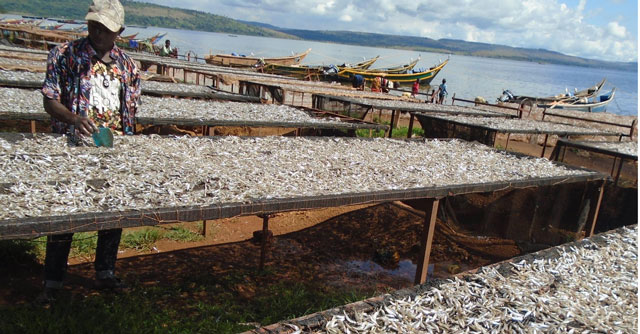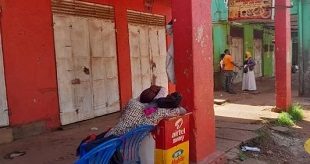
Buikwe, Uganda | THE INDEPENDENT | Silverfish traders and processors at Kiyindi Landing site in Buikwe District have decried the drop in prices, partly as a result of the closure of the Uganda-Rwanda border.
Rwanda closed its border to Uganda earlier in February this year and also blocked its nationals from crossing into Uganda saying their security could not be guaranteed while they were in Uganda.
But the traders comprising of 40 women and 20 men operating under Kiyindi Women Fish Processors Association say that Rwanda offered the biggest market for silverfish from Kiyindi landing site, prior to the border closure. Currently, a basin of silverfish costs 25, 000 Shillings down from between 40, 000 and 50,000 Shillings last year.
Peruth Logose, the Association Chairperson explains that they are now struggling to find markets for their silverfish out of Uganda, forcing them to limit supplies to local supermarkets and animal feed processors.
She was speaking during the Fisheries day celebrations at Kiyindi Landing site, Buikwe District on Thursday.
Martha Nangobi, one of the silverfish traders says that they have tried to identify alternative markets in countries like South Sudan and Kenya but the prices are lower than what Rwanda offered.
Deogratius Kakembo, a fisherman at Kiyindi landing site notes that they are forced to give out silverfish to local traders on debt.
Dr John Walakira, a Senior Research Officer at the National Fisheries Resources Institute- (NaFIRRI) says they have reduced post-harvest losses of silverfish by 5 per cent from 30 per cent in a period of five years.
Meanwhile, Stella Mbabazi, a Fisheries Inspector in Ministry of Agriculture, Animal Industry and Fisheries-MAAIF, says they are trying to coordinate with various private partners and develop various technologies to ensure more market for the silverfish.
*****
URN
 The Independent Uganda: You get the Truth we Pay the Price
The Independent Uganda: You get the Truth we Pay the Price



SILVERFISH AND MUKENE ARE NOT THE SAME THING
——————————————-
ABOUT SILVERFISH (source: Wikipedia)
A silverfish (Lepisma saccharina) is a small, wingless insect in the order Zygentoma (formerly Thysanura). Its common name derives from the animal’s silvery light grey colour, combined with the fish-like appearance of its movements. However, the scientific name (L. saccharina) indicates the silverfish’s diet consists of carbohydrates such as sugar or starches.
Silverfish are nocturnal insects typically 13–25 mm (0.5–1.0 in) long.[2] Their abdomens taper at the end, giving them a fish-like appearance.[3] The newly hatched are whitish, but develop a greyish hue and metallic shine as they get older.[4] They have two long cerci and one terminal filament at the tip of the abdomen between the cerci. They also have two small compound eyes, despite other members of Zygentoma being completely eyeless, such as the family Nicoletiidae.[3][5]
Like other species in Apterygota, silverfish are completely wingless.[3][6] They have long antennae, and move in a wiggling motion that resembles the movement of a fish.[7] This, coupled with their appearance and silvery scales, inspires their common name. Silverfish typically live for two to eight years.[4] Silverfish are agile runners and can outrun most of their predators (including wandering spiders and centipedes). However, such running is possible only on horizontal surfaces, as they lack any additional appendages, and therefore are not fast enough to climb walls at the same speed.[citation needed] They also avoid light.[8]
Silverfish are a cosmopolitan species, found in Africa, the Americas, Australia, Eurasia, and other parts of the Pacific.[9] They inhabit moist areas, requiring a relative humidity between 75% and 95%.[10] In urban areas, they can be found in attics, basements, bathtubs, sinks, kitchens, old books, classrooms, and showers.[4]
Silverfish consume matter that contains polysaccharides, such as starches and dextrin in adhesives.[4] These include book bindings, carpet, clothing, coffee, dandruff, glue, hair, some paints, paper, photos, plaster, and sugar. They will damage wallpaper in order to consume the paste.[15] Silverfish can also cause damage to tapestries. Other substances they may eat include cotton, dead insects, linen, silk, leftover crumbs, or even their own exuvia (moulted exoskeleton). During famine, a silverfish may even consume leatherware and synthetic fabrics. Silverfish can live for a year or more without eating if water is available.[2][4][16]
Silverfish are considered household pests, due to their consumption and destruction of property.[2] However, although they are responsible for the contamination of food and other types of damage, they do not transmit disease.[4][17] Earwigs, house centipedes, and spiders are known to be predators of silverfish.[18][19]
ABOUT MUKENE (source: Wikipedia)
The silver cyprinid (Rastrineobola argentea) also known as the Lake Victoria sardine or mukene, is a species of pelagic, freshwater ray-finned fish in the carp family, Cyprinidae from East Africa. it is the only member of the genus Rastrineobola.
A small silvery fish which has a strongly compressed body covered in large scales[3] with a pearlescent sheen and a yellow tail, and can grow to a length of 9 cm (3.5 in).[4] The lateral line is below the midpoint of the body and runs to the lower part of the caudal peduncle. The cheek is covered by delicate suborbital bones.[4]
The silver cyprinid is known from the drainage basin of Lake Victoria, Lake Kyoga, Lake Nabugabo and the Victoria Nile, occurring in Kenya, Uganda and Tanzania.[1]
Dagaa/mukene/omena from Lake Victoria is an important fish in the diet of people in eastern and southern Africa.[6] The fish is caught during moonless nights and in the morning it is sold to women who spread it out for drying in the sun. This takes one day or more, depending on the weather. Unfortunately, the best catches are made during the rainy season when drying is difficult resulting in lower quality of the dried product. The lowest quality is however still usable as chicken feed. Drying is often done on the sand, on rocks or on old nets spread on the grass. Drying racks have not caught on, neither have salting or smoking. The dried fish is packed in sacks and traders take the fish to the market. A major wholesale market for dried dagaa is in Mwanza, Tanzania, from where it is transported all over eastern and southern Africa for use as food or chicken feed.[3] Sometimes it competes with dried kapenta which is usually preferred though more expensive.[7]
————-
PLEASE STOP CALLING MUKENE “SILVERFISH”. SILVERFISH IS AN INSECT, NOT A FISH.